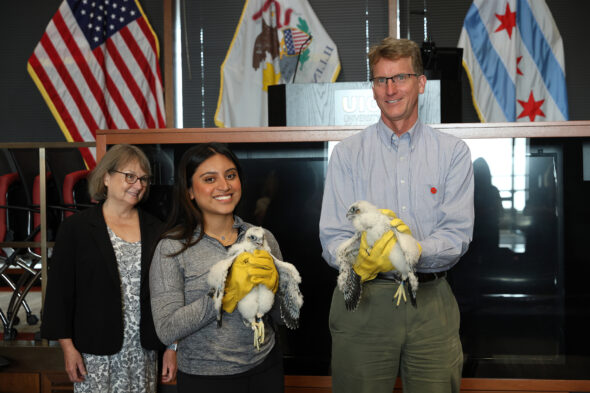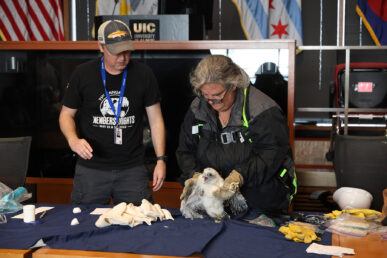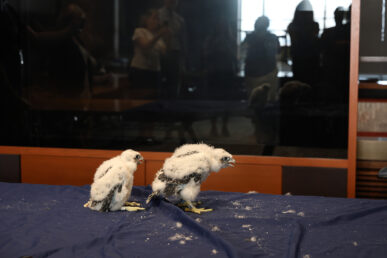UIC welcomes new falcon chicks to University Hall

When Gina Vasquez held the weeks-old peregrine falcon chick — which resembled a large white cotton ball — in her gloved hand, the biological sciences major knew she correctly had decided to pursue a career as a veterinarian.
Vasquez, who is graduating from the University of Illinois Chicago in December, was one of several people present recently as two chicks were banded by ornithologists from the Chicago Field Museum.
The Chicago native was happy to know that the birds of prey were present and part of the local ecology, even in her city. As she held a chick, the bird and its sibling squawked and shrieked to return to its roost and nervously fluttered their small wings, sending their down feathers floating in the air.
“They were definitely softer than I thought,” Vasquez said. “I love all kinds of animals, and every interaction I have with one just makes me want to be a veterinarian even more.”
The chicks, which are both believed to be males, were born about 23 days earlier to an adult female who was banded at the same time as her offspring. The peregrine father, named Mouse, has nested on the 28th floor of University Hall since 2015 and is 15 years old.
Peregrines have nested at University Hall for decades and have their own livestream.
Eric Stabb, UIC professor and head of biological sciences, who held one of the chicks at the banding, said he has loved birds since he was a boy. Over the years, a biology student has been invited to witness the banding, Stabb said, and this year Vasquez had the honor of witnessing the banding of the newest brood.
“When I was a kid, eagles and falcons were really highly endangered in the United States,” Stabb said. “It makes my heart warm that in downtown Chicago and other metropolitan areas we can see these amazing birds.”
Field Museum ornithologists Mary Hennen, Dylan Maddox and Ben Marks first used a fishing net to catch the mother and then went out on the ledge to retrieve the chicks. All were carefully brought into the building and banded. Blood samples were taken, which could ultimately be used to confirm their gender. The leg bands have digits that are unique to each bird. Subsequent readings of the bands can provide data on peregrine survival, dispersal distances, population growth rates and more.
“You’re archiving the blood sample and somewhere along the line, we might be able to look at genetics, blood-borne parasites or parentage,” Hennen said.
She said that peregrines have nested at University Hall since 1999, but over the last two years, a second pair of falcons had nested on campus nearby. The second family was not successful in breeding last year because they laid their eggs in a gutter. The eggs did not survive heavy rains.
Hennen said falcons can live up to 20 years, and there are an estimated 12 to 15 pairs in the Chicago area. While initially endangered, they have rebounded due to heightened awareness and stopping the use of deadly insecticides such as DDT.
“It’s a wonderful comeback of a species that was almost wiped out by humans,” she said. “Looking at peregrine falcons, it’s a nice barometer of the health of the environment out there.”
Hennen said recent stories about falcons attacking pedestrians in the Loop were overblown and simply reflect a mother protecting her nest and fledglings. The takeaway is that the birds should be given as much space as possible.
Karen Colley, UIC acting provost and vice chancellor for academic affairs, also witnessed the banding. She said UIC is a refuge in an urban environment for these birds, who return every year to nest.
“These peregrine falcon families have become part of the UIC family, and we eagerly await their arrival each spring and the hatching of their chicks,” Colley said. “To me, they have become a symbol of the spirit of resilience that characterizes our students, who, like the chicks, grow right before our eyes during their time at UIC.”


